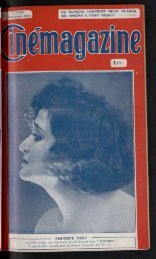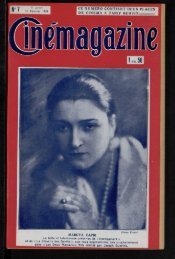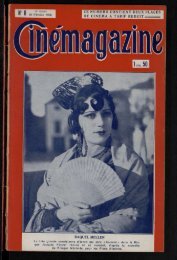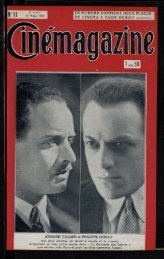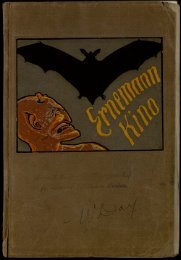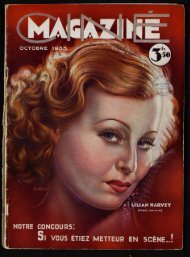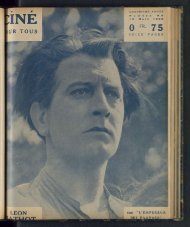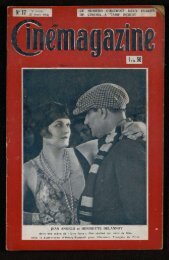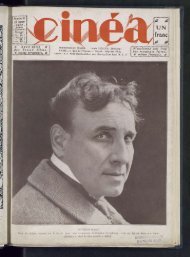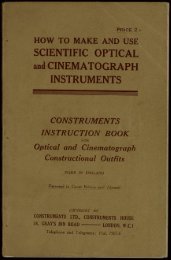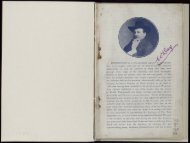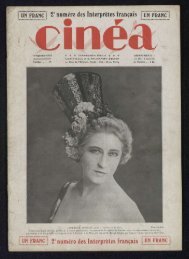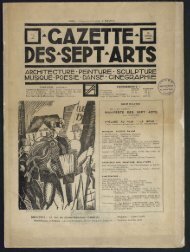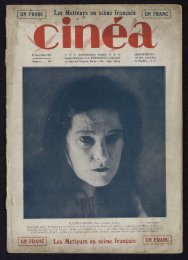Untitled
Untitled
Untitled
You also want an ePaper? Increase the reach of your titles
YUMPU automatically turns print PDFs into web optimized ePapers that Google loves.
92 MODERN MAGIC LANTERNS.<br />
and render parallel the rays of light, D is the cardboard<br />
with the slit, E the objective, and F the prism, the screen<br />
being beyond the latter in the direction indicated by the<br />
lines of light. The slit being placed in position, it must be<br />
focussed upon the screen in the usual way ; too great a<br />
degree of enlargement should not be attempted, or the<br />
illumination will be feeble. When focussed, the lantern<br />
must be turned round bodily until its position with reference<br />
to the screen is as it would be if the latter were placed<br />
across the right-hand bottom corner in Fig. 68, and the<br />
prism placed in front of the objective as shown. A little<br />
Fig. 68. ARRANGEMENT OF APPARATUS FOR PROJECTING THE SPECTRUM.<br />
adjustment will be necessary to get the best result ; for<br />
this reason the arrangements should all be made, and the<br />
prism put into its place before the audience are present.<br />
The best position for the prism to occupy is that in which<br />
it bends aside the beam of light the least, and this should<br />
be fo and as nearly as possible by experiment. If all has<br />
been properly arranged, the beam of light from the lantern<br />
will be found to be split up in its passage through the<br />
prism, and to be widened out into a band of coloured<br />
light, one end of which is red, and the other violet, with<br />
the other colours in between these two extremes. This<br />
band is the spectrum.<br />
By inserting in the path of the beam' as it emerges from<br />
the objective, coloured glasses or stained gelatine fili5as, the<br />
THE LANTERN-SPECTROSCOPE,<br />
POLARISCOPE, ETC. 93<br />
absorption of such media can roughly be shown. Solutions<br />
of various substances can also be employed, using for the<br />
purpose a cell similar to that shown in Fig. 61. Solutions<br />
of potassium permanganate, of potassium bichromate, of<br />
many of the aniline dyes, etc., give interesting results when<br />
shown in this manner. With glass or stained films the<br />
absorption is better shown if the coloured material is in<br />
contact with the slit itself, covering, say, the lower half of<br />
it. A sharp line upon the screen will then be seen to<br />
divide the spectrum into two distinct parts, the upper one<br />
being the spectrum of the light employed after it has passed<br />
through the coloured film, the lower one simply the spectrum<br />
of the light itself.<br />
An interesting experiment consists in saturating a sheet<br />
of white paper with a solution of quinine sulphate in water<br />
rendered slightly acid with sulphuric acid. The paper<br />
should be allowed to dry, and then be mounted on a sheet<br />
of card side by side with a similar piece of paper which has<br />
not undergone the treatment with quinine, in such a way<br />
that the two papers are separated by a straight line running<br />
right across the card. If now a very bright spectrum be<br />
thrown upon such a card, so that the upper half of the band<br />
of colours falls on the plain paper, and the other on that<br />
treated with quinine, it will be seen that a greater length of<br />
spectrum at the violet end is visible on the latter than on the<br />
former. It will most likely be necessary, in order to show<br />
this distinctly, to cover up all the spectrum between the<br />
blue and the red, as otherwise<br />
the brilliancy of that portion<br />
will drown the darker violet, and the experiment be less<br />
striking. This is shown better with the electric arc than<br />
with limelight, although with care it can be very plainly<br />
demonstrated even with the latter.<br />
The experiment can be elaborated by interposing, in the<br />
path of the beam of light, a glass cell containing the solution<br />
of quinine. This will at once alter the appearance of the<br />
spectrum, which will then appear no longer on the one paper<br />
than on the other, but on the other hand the solution itself<br />
will exhibit a very beautiful blue fluorescence. Various<br />
other substances can be used in place of the quinine with<br />
varying results.



